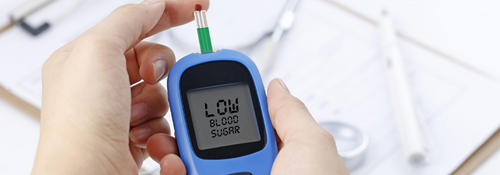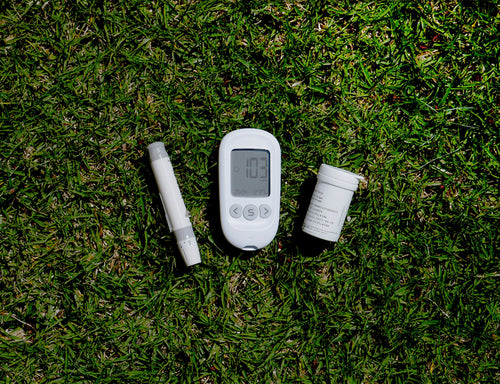Tips on Managing Your Blood Glucose Levels
The amount of sugar we consume directly impacts our health. Taking steps to regulate your blood sugar levels now could prevent you from developing serious conditions such as hyperglycaemia or diabetes.
What is blood glucose?
‘Blood glucose’ is a term used when referring to the amount of sugar in our blood. It is also sometimes referred to as ‘blood sugar’. Glucose is the form of sugar our body uses as its primary source of energy. Glucose is found in varying levels in the food that we eat. It can be absorbed in its pure form without the need for digestion, or the body can convert carbohydrates into sugar.
Glucose is carried through the blood stream from which it is distributed to the cells in our bodies.
What happens when you have high blood sugar?
When blood glucose levels are too high for considerable periods of time, hyperglycaemia can set in. According to the NHS, the normal blood glucose target is 4 – 7mmol/L before eating and under 8.5 to 9mmol/L 2 hours after a meal.
Hyperglycaemia can damage vessels which carry blood to vital organs such as the heart, kidneys, eyes and liver.
If it’s left untreated it can lead to heart disease, stroke, vision problems and kidney disease, amongst many other conditions.
High blood sugar coupled with an inactive lifestyle could also lead to type 2 diabetes, when the body no longer produces enough insulin, or its cells become insulin resistant.
What causes high blood sugar?
High blood sugar levels are usually caused by one or a combination of the factors below:
Eating too many carbohydrates and sugary foods
It goes without saying that eating too much sugar is going to increase your blood sugar levels, however you must also remember that carbohydrates are a form of sugar. Eating large, carbohydrate rich meals can flood your body with sugars and cause a spike in blood sugar levels.
Lack of exercise
Leading a sedentary lifestyle is bad for your health generally, however it is also known to impact the body’s ability to regulate blood glucose levels. This could be because you’re not burning enough glucose through activity and exercise. Your body may then turn this sugar into fat.
Issues with insulin control
Insulin is a hormone produced by the pancreas. It regulates the rate at which fats, protein and carbohydrates are metabolised and drives the uptake of glucose from the blood into fat, liver and skeletal muscle cells.
If the body doesn’t produce enough insulin or it no longer responds to the insulin which is produced, blood sugar levels will become unstable.
Other illnesses
When suffering with other illnesses such as the flu, levels of glucose in the blood can rise significantly over the course of a day.
What can you do to keep blood glucose levels stable?
Diet management
Carefully managing what you eat is the most effective way to regulate your blood sugar.
Try to consume foods which are slowly digested as they are less likely to cause a spike in blood glucose. Pay attention to carbohydrates as they provide sugars for your body.
Use the Glycaemic Index (GI) to help with meal planning.
Glycaemic Index
The Glycaemic Index ranks carbohydrate foods based on how they interact with blood glucose levels. Measured on a scale of 0 – 100, it is recommended that you try to keep to as many carbs which score 55 or under to maintain steady blood sugar levels. Usually, the higher the fat and fibre content of a carbohydrate, the lower it is on the GI index.
Carbs with a low GI score include:
- Oatmeal
- Muesli
- Sweet potatoes
- Pasta
- Most fruits & legumes
- Non – starchy vegetables and carrots
Carbs you should avoid
- White bread
- Bagels
- Rice cakes
- White potatoes
- Popcorn
- Short grain white rice
Do note though that GI doesn’t account for portion size, so if you consume large quantities of low GI foods, they can still cause your blood sugar to spike.
Regular exercise and sleep
Daily exercise is a key component of effective blood sugar management. When you are active, your muscles have direct access to the glucose supply stored in your blood, helping to keep blood sugar levels down. Additionally, muscle movement makes your insulin more effective, so you blood can better deliver energy to your cells. This is particularly important for individuals who suffer from type 2 diabetes.
Sleep and blood sugar levels
The connection between sleep and blood glucose levels has been well documented for some time. It is while we sleep that the body regenerates cells and maintains hormonal balance.
By depriving ourselves of sleep we are prone to reducing our metabolic rate (the way our body uses food for energy) and the efficacy of our immune system.
Focus on getting your head down at the same time every night and try to get in 7 – 9 hours of uninterrupted sleep.
What happens when you get low blood sugar?
Poor blood glucose management can also lead to low blood sugar levels. Symptoms often include dizziness, trembling, nausea, sweating and loss of consciousness.
Hypoglycaemia as it is also known occurs when there isn’t enough glucose in the blood to supply the body with the energy it needs. Unlike hyperglycaemia, low blood sugar is more easily treated by eating a sugary snack or taking a glucose supplement.
Wrapping it up
Managing sugar intake and paying careful attention to blood sugar levels should be part of everybody’s routine. According to Diabetes UK, over 500,000 people in the UK are thought to have diabetes but are not aware of it as the symptoms can be difficult to spot.
If you feel you may be at risk, don’t delay – book an appointment with your GP for a check-up.






